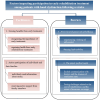Exploring Barriers and Facilitators to Early Rehabilitation in Post-Stroke Hand Dysfunction: A Qualitative Study
- PMID: 40771864
- PMCID: PMC12326438
- DOI: 10.2147/JMDH.S533560
Exploring Barriers and Facilitators to Early Rehabilitation in Post-Stroke Hand Dysfunction: A Qualitative Study
Abstract
Background: Early rehabilitation can improve limb function and enhance quality of life for patients with hand dysfunction following a stroke. Currently, there is a lack of research exploring the factors that facilitate or hinder the participation of patients with hand dysfunction in early rehabilitation. Exploring these factors is crucial for the formulation of strategies aimed at boosting patients' motivation towards early rehabilitation and cultivating their proactive engagement.
Aim: This study aimed to explore the barriers and facilitators to early rehabilitation in post-stroke hand dysfunction.
Methods: This is a descriptive qualitative study. 15 patients with post-stroke hand dysfunction were selected using the purposive sampling method. Data were collected through semi-structured, face-to-face, in-depth interviews conducted at a tertiary hospital in Shanghai, China, between March and April 2024. The data were coded using NVivo software and analyzed via Braun and Clarke's reflective thematic approach.
Results: Four themes were identified, encompassing eight sub-themes: (1) gaining benefits from early treatments, (2) active participation of individuals and their families, (3) a low level of perceived self-efficacy, and (4) unmet medical needs.
Conclusion: The likelihood of patients with hand dysfunction following a stroke participating in early rehabilitation treatments is influenced by numerous factors. Intervention strategies can be tailored around these factors and may include educating patients and their families about stroke and early rehabilitation, training healthcare professionals (HCPs) to enhance their skills, providing professional support to patients after discharge and optimizing health insurance policies.
Keywords: barriers; early rehabilitation treatments; facilitators; hand dysfunction; qualitative study; stroke.
© 2025 Qin et al.
Conflict of interest statement
The authors declare no competing interests.
Similar articles
-
Health professionals' experience of teamwork education in acute hospital settings: a systematic review of qualitative literature.JBI Database System Rev Implement Rep. 2016 Apr;14(4):96-137. doi: 10.11124/JBISRIR-2016-1843. JBI Database System Rev Implement Rep. 2016. PMID: 27532314
-
Neonatal Nurses' Understanding of the Factors That Enhance and Hinder Early Communication Between Preterm Infants and Their Parents: A Narrative Inquiry Study.Int J Lang Commun Disord. 2025 Jul-Aug;60(4):e70093. doi: 10.1111/1460-6984.70093. Int J Lang Commun Disord. 2025. PMID: 40653954 Free PMC article.
-
Barriers and facilitators of inpatients and healthcare professionals prior to the implementation of a Multidisciplinary Lifestyle-Focused Approach in the Treatment of Inpatients With Mental Illness (MULTI+): The MULTI+ Study II.Implement Res Pract. 2025 Jul 6;6:26334895251351663. doi: 10.1177/26334895251351663. eCollection 2025 Jan-Dec. Implement Res Pract. 2025. PMID: 40630921 Free PMC article.
-
Barriers and facilitators to the implementation of lay health worker programmes to improve access to maternal and child health: qualitative evidence synthesis.Cochrane Database Syst Rev. 2013 Oct 8;2013(10):CD010414. doi: 10.1002/14651858.CD010414.pub2. Cochrane Database Syst Rev. 2013. PMID: 24101553 Free PMC article.
-
Speech and Language Therapy Weekend Service in Inpatient Rehabilitation: A Qualitative Study Exploring Perspectives of People With Stroke.Int J Lang Commun Disord. 2025 Jul-Aug;60(4):e70077. doi: 10.1111/1460-6984.70077. Int J Lang Commun Disord. 2025. PMID: 40605708 Free PMC article.
References
LinkOut - more resources
Full Text Sources
Miscellaneous


